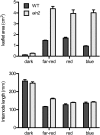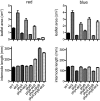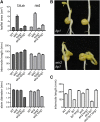Ethylene Signaling Influences Light-Regulated Development in Pea
- PMID: 25792252
- PMCID: PMC4577373
- DOI: 10.1104/pp.15.00164
Ethylene Signaling Influences Light-Regulated Development in Pea
Abstract
Plant responses to light involve a complex network of interactions among multiple plant hormones. In a screen for mutants showing altered photomorphogenesis under red light, we identified a mutant with dramatically enhanced leaf expansion and delayed petal senescence. We show that this mutant exhibits reduced sensitivity to ethylene and carries a nonsense mutation in the single pea (Pisum sativum) ortholog of the ethylene signaling gene ETHYLENE INSENSITIVE2 (EIN2). Consistent with this observation, the ein2 mutation rescues the previously described effects of ethylene overproduction in mature phytochrome-deficient plants. In seedlings, ein2 confers a marked increase in leaf expansion under monochromatic red, far-red, or blue light, and interaction with phytochromeA, phytochromeB, and long1 mutants confirms that ein2 enhances both phytochrome- and cryptochrome-dependent responses in a LONG1-dependent manner. In contrast, minimal effects of ein2 on seedling development in darkness or high-irradiance white light show that ethylene is not limiting for development under these conditions. These results indicate that ethylene signaling constrains leaf expansion during deetiolation in pea and provide further evidence that down-regulation of ethylene production may be an important component mechanism in the broader control of photomorphogenic development by phytochrome and cryptochrome.
© 2015 American Society of Plant Biologists. All Rights Reserved.
Figures







Similar articles
-
Cryptochrome 1 contributes to blue-light sensing in pea.Plant Physiol. 2005 Nov;139(3):1472-82. doi: 10.1104/pp.105.067462. Epub 2005 Oct 21. Plant Physiol. 2005. PMID: 16244154 Free PMC article.
-
Light regulation of gibberellin biosynthesis in pea is mediated through the COP1/HY5 pathway.Plant Cell. 2009 Mar;21(3):800-13. doi: 10.1105/tpc.108.063628. Epub 2009 Mar 27. Plant Cell. 2009. PMID: 19329557 Free PMC article.
-
A role for ethylene in the phytochrome-mediated control of vegetative development.Plant J. 2006 Jun;46(6):911-21. doi: 10.1111/j.1365-313X.2006.02754.x. Plant J. 2006. PMID: 16805726
-
A hidden link between leaf development and senescence.Plant Sci. 2018 Nov;276:105-110. doi: 10.1016/j.plantsci.2018.08.006. Epub 2018 Aug 17. Plant Sci. 2018. PMID: 30348308 Review.
-
Mechanistic Insights in Ethylene Perception and Signal Transduction.Plant Physiol. 2015 Sep;169(1):85-95. doi: 10.1104/pp.15.00845. Epub 2015 Aug 5. Plant Physiol. 2015. PMID: 26246449 Free PMC article. Review.
Cited by
-
Genome-Wide Association Study to Identify Possible Candidate Genes of Snap Bean Leaf and Pod Color.Genes (Basel). 2023 Dec 18;14(12):2234. doi: 10.3390/genes14122234. Genes (Basel). 2023. PMID: 38137056 Free PMC article.
-
Crosstalk between Brassinosteroids and Ethylene during Plant Growth and under Abiotic Stress Conditions.Int J Mol Sci. 2018 Oct 22;19(10):3283. doi: 10.3390/ijms19103283. Int J Mol Sci. 2018. PMID: 30360451 Free PMC article. Review.
-
Ethylene, a Hormone at the Center-Stage of Nodulation.Front Plant Sci. 2015 Dec 22;6:1121. doi: 10.3389/fpls.2015.01121. eCollection 2015. Front Plant Sci. 2015. PMID: 26834752 Free PMC article. Review.
-
The role of strigolactones and ethylene in disease caused by Pythium irregulare.Mol Plant Pathol. 2016 Jun;17(5):680-90. doi: 10.1111/mpp.12320. Epub 2015 Nov 11. Mol Plant Pathol. 2016. PMID: 26377026 Free PMC article.
-
Nitric Oxide, Ethylene, and Auxin Cross Talk Mediates Greening and Plastid Development in Deetiolating Tomato Seedlings.Plant Physiol. 2016 Apr;170(4):2278-94. doi: 10.1104/pp.16.00023. Epub 2016 Feb 1. Plant Physiol. 2016. PMID: 26829981 Free PMC article.
References
-
- Alonso JM, Hirayama T, Roman G, Nourizadeh S, Ecker JR (1999) EIN2, a bifunctional transducer of ethylene and stress responses in Arabidopsis. Science 284: 2148–2152 - PubMed
-
- Aubert G, Morin J, Jacquin F, Loridon K, Quillet MC, Petit A, Rameau C, Lejeune-Hénaut I, Huguet T, Burstin J (2006) Functional mapping in pea, as an aid to the candidate gene selection and for investigating synteny with the model legume Medicago truncatula. Theor Appl Genet 112: 1024–1041 - PubMed
-
- Bailey-Serres J, Fukao T, Gibbs DJ, Holdsworth MJ, Lee SC, Licausi F, Perata P, Voesenek LA, van Dongen JT (2012) Making sense of low oxygen sensing. Trends Plant Sci 17: 129–138 - PubMed
Publication types
MeSH terms
Substances
Associated data
- Actions
LinkOut - more resources
Full Text Sources
Other Literature Sources

